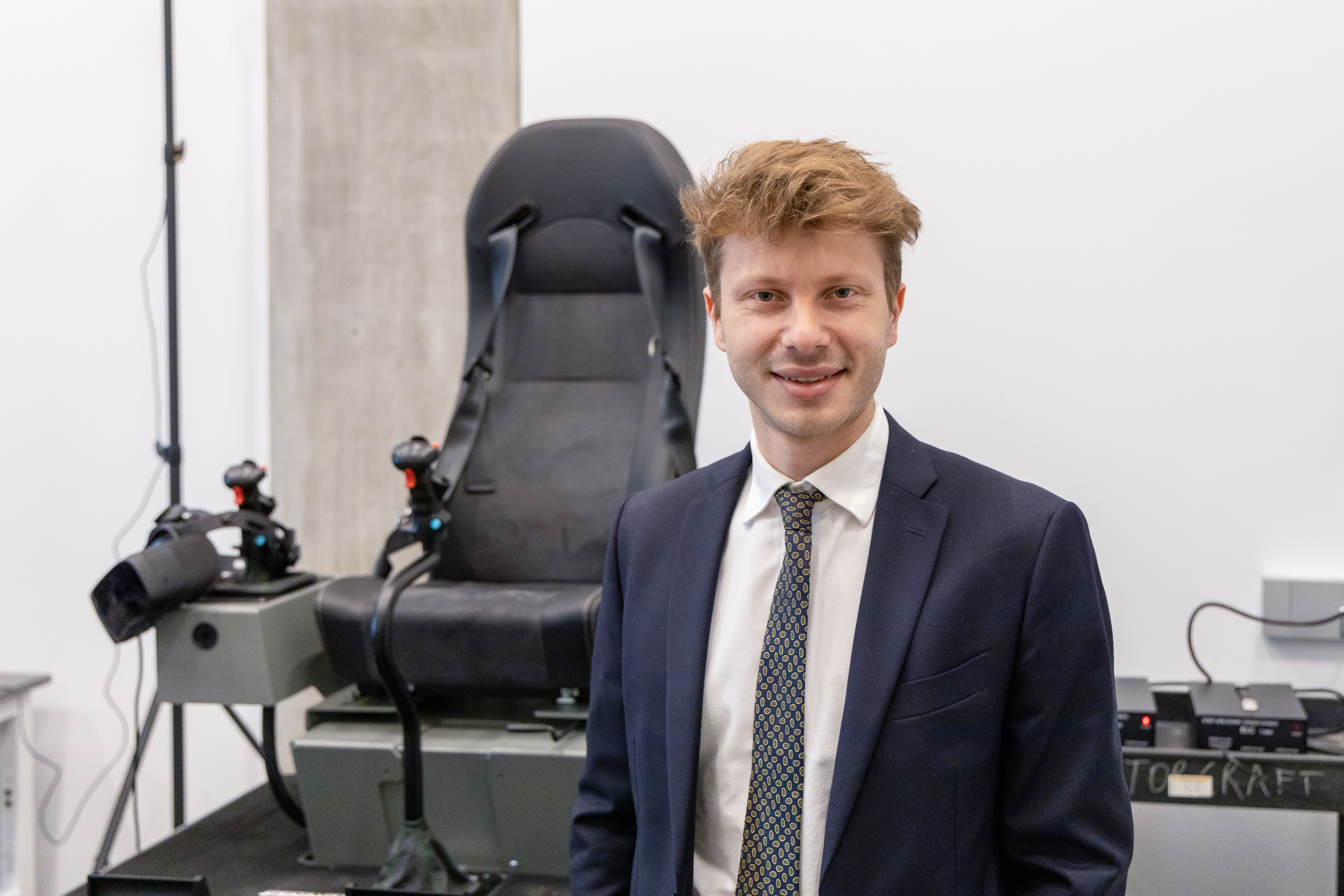
|
 |
Aerospace engineering graduate student Michael Morcos tries out one of the BRUNNER motion-base VR simulators installed at University of Maryland (UMD) assistant professor Umberto Saetti's Extended Reality Flight Simulation and Control Lab. UMD is one of the only universities in the U.S. to house motion-base VR simulation equipment, which can reproduce flying conditions in a wide variety of aircraft. Photo credit: University of Maryland/Joanna Avery. |
|
New motion-base Virtual Reality (VR) simulators installed at the University of Maryland’s (UMD) E.A. Fernandez IDEA Factory will enable researchers and students to develop and test advanced flight control systems and innovative cueing methods, and to study human-machine interaction.
Used in combination with full-body haptic feedback suits, the simulators support fully immersive, Extended Reality (XR) experiences that replicate piloting a variety of aircraft, including fixed wing airplanes as well as rotorcraft.
“We’re harnessing extended reality in ways that push the research envelope and support exciting new applications,” said Umberto Saetti, who joined the UMD aerospace engineering (AE) faculty in 2022 as an assistant professor. The equipment is housed at Saetti’s Extended Reality Flight Simulation and Control Lab at the IDEA Factory.
The NOVASIM VR Simulator is designed by BRUNNER, a leading company in virtual-reality flight simulation hardware, and provides “a fully equipped motion platform, connected with all necessary units, including Joystick, rudder pedals and yokes in a more lightweight, flexible way compared to other FFS,” the company said.

Umberto Saetti, assistant professor, UMD Department of Aerospace Engineering
It represents a step forward from the bulky systems–often costing millions of dollars per unit–that were used in the past for similar types of research, said Saetti, who teaches and conducts research as part of the AE department’s renowned Alfred Gessow Rotorcraft Center (AGRC).
“We used to rely on large projected screens that were mounted on large motion base systems, and you would need a different cockpit model for each type of aircraft that you wanted to simulate,” he said. “In our system, by contrast, we can just swap out one virtual cockpit for another, and plug in any flight dynamics that we are interested in.”
Haptic TESLASUIts, meanwhile, allow users to experiment with using tactile stimuli to obtain information on aircraft motion, desired landing zone locations and rotorcraft noise via tactile rather than visual or auditory cues. “Through electro-muscular stimulation, the pilot can receive this information through an alternate sensory channel,” Saetti said.
In military contexts, haptics could be used to alert pilots that an aircraft is being followed, indicating the other aircraft’s relative position, velocity, and acceleration. Saetti also plans to utilize the system to build on his previously published research on flight control systems in helicopters when landing on ships.
The technology also opens up the possibility that users who do not meet the visual requirements to pilot aircraft could someday do so. Indeed, with haptics, an aircraft could even be flown by a visually impaired or blind pilot.
The idea has precedents. In 1946, Helen Keller took the controls of a four-engine Douglas C-5 Skymaster and flew it for 20 minutes, en route from Rome to Paris. In 2002, deaf-blind teenager Katie Inman successfully demonstrated the use of tactical signing in flight instruction, flying the plane with one hand while communicating with her instructor through signs drawn in her other palm.
In a virtual flying environment equipped with haptics, a pilot like Keller or Inman could learn to fly an aircraft without needing to see or hear. “Say a helicopter rolls to the right,” Saetti said. “The pilot would recognize this through the feel on his or her body, and also be able to take the correct steps to recover, by detecting the changes in haptic stimulation.”
Alison Flatau, chair of the UMD aerospace engineering department, said she is excited to see Saetti and other faculty investigating novel areas of research with the help of advanced technologies. “Aerospace engineering is an increasingly interdisciplinary fast-moving field, and we aim to be on the leading edge of research that embraces creative insights and opportunities to advance our field,” Flatau said. “The new systems being made available at Dr. Saetti’s lab provide capabilities that are available at few other universities.”
The E.A. Fernandez IDEA Factory was opened at UMD in 2022 with the goal of fostering technology innovation and advances through collaboration across engineering, the arts, business, and science. In addition to the Extended Reality Flight Simulation and Control Lab, it hosts the Maryland Robotics Center’s Robotics and Autonomy Lab as well as other labs and facilities.
Related Articles:
When Vision Fails, a Suit Could Steer Pilots to Safety
Fly by Feel - Can we Fly Without Vision?
April 27, 2023
|

